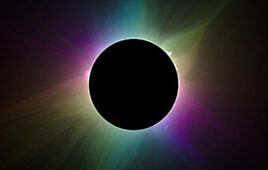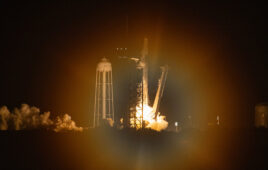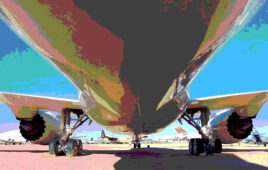
Courtesy of ISS Expedition 7 Crew, EOL, NASA
The presence of rare nitrogen molecules in the atmosphere may shed light on the makeup of life-supporting planets.
Researchers from UCLA have measured the amount of a rare and heavy form of nitrogen gas (15N15N) in the air and discovered that the gas is significantly more abundant than the scientists expected.
“This excess was not known before because nobody could measure it,” senior author Edward Young, a UCLA professor of geochemistry and cosmochemistry, said in a statement. “Our one-of-a-kind Panorama mass spectrometer allows us to see this for the first time.
“We conducted experiments showing that the only way for this excess of 15N15N to occur is by rare reactions in the upper atmosphere,” he added. “But it also gives us a clue about what signatures of other planets might look like, especially if they are capable of supporting life as we know it.”
The Earth’s atmosphere is rich in nitrogen gas, setting the planet apart from other rocky planets and moons in the solar system.
The majority of nitrogen has an atomic mass of 14 and less than one percent of nitrogen has an extra neutron. While this heavy isotope, nitrogen-15, is rare, N2 molecules that contain two nitrogen-15s—which chemists call 15N15N—are the rarest of all N2 molecules.
The Earth’s atmosphere contains about 2 percent more 15N15N than can be accounted for by geochemical processes occurring near the Earth’s surface. The enrichment of 15N15N in the atmosphere is unique to Earth.
“We didn’t believe the measurements at first, and spent about a year just convincing ourselves that they were accurate,” lead author Laurence Yeung, an assistant professor of Earth, environmental and planetary sciences at Rice University, said in a statement.
According to Yeung, the researchers began the study four years ago.
“At that time, no one had a way to reliably quantify 15N15N,” he said. “It has an atomic mass of 30, the same as nitric oxide.
“The signal from nitric oxide usually overwhelms the signal from 15N15N in mass spectrometers,” Yeung added.
The difference in mass between nitric oxide and 15N15N is about two one-thousandths the mass of a neutron.
The researchers conducted experiments on N2-consuming and N2-producing bacteria that allowed them to determine their 15N15N signatures. The experiments suggested that there should be more 15N15N in air than random pairings of nitrogen-14 and nitrogen-15 would produce—an enrichment of about one part per 1,000.
“There was a bit of enrichment in the biological experiments, but not nearly enough to account for what we’d found in the atmosphere,” Yeung said. “In fact, it meant that the process causing the atmospheric 15N15N enrichment has to fight against this biological signature. They are locked in a tug-of-war.”
The researchers found zapping mixtures of air with electricity, which simulates the chemistry of the upper atmosphere, could produce enriched levels of 15N15N like they measured in air samples. They also tested air samples from ground level and from altitudes of about 20 miles, as well as dissolved air from shallow ocean water samples.
“We think the 15N15N enrichment fundamentally comes from chemistry in the upper atmosphere, at altitudes close to the orbit of the International Space Station,” Yeung said. “The tug-of-war comes from life pulling in the other direction, and we can see chemical evidence of that. We can see the tug-of-war everywhere.”




